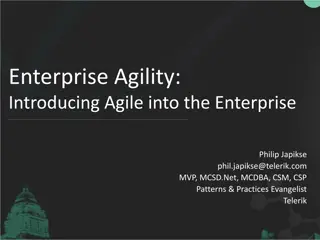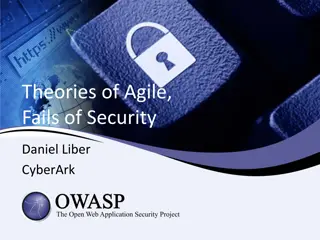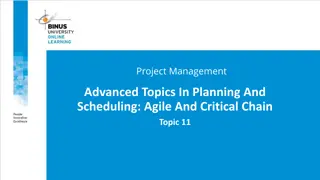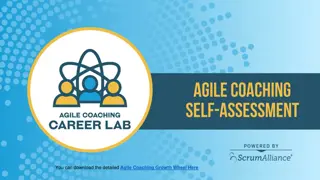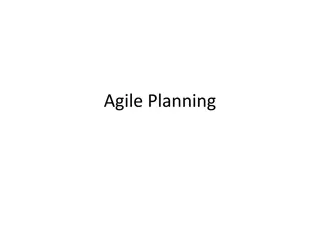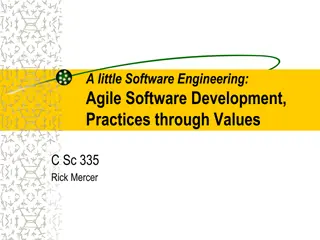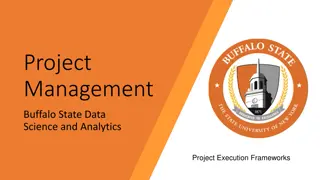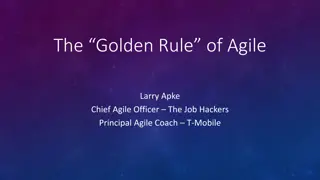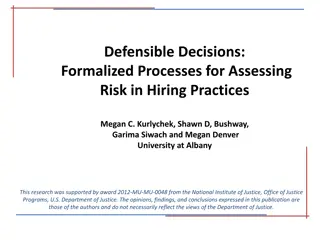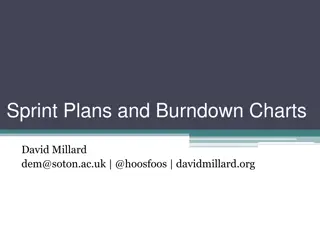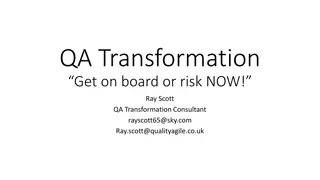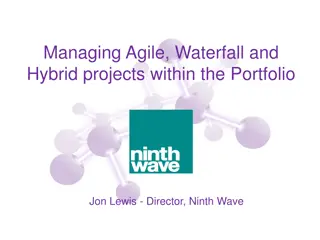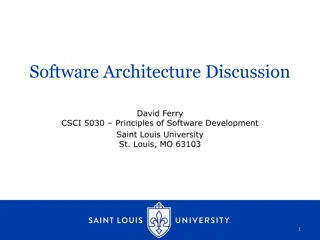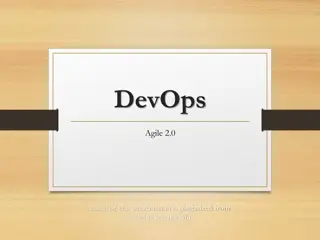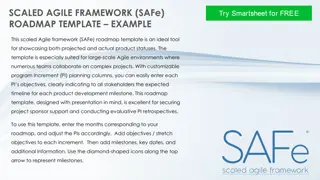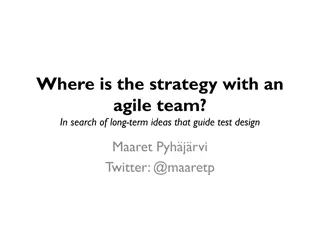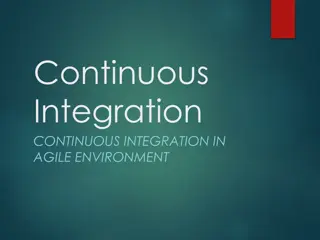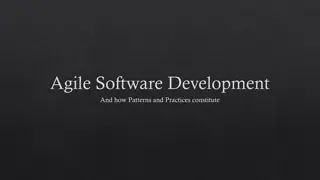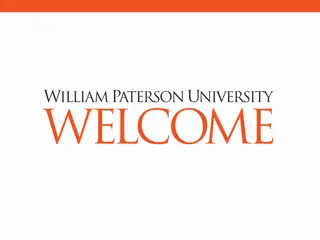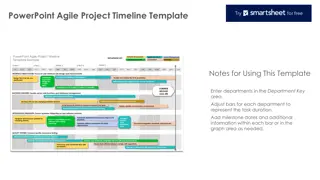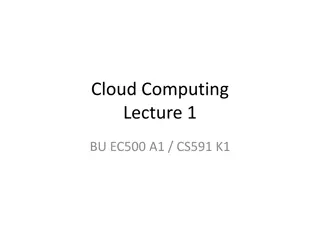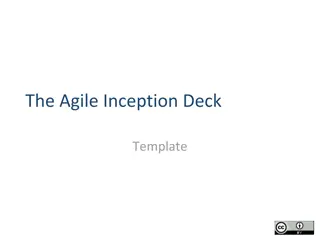Hiring and Management for Agile Company Overview
This overview delves into the crucial aspects of hiring and managing talent for an agile company, emphasizing the skills, principles, and strategies required for success in an agile work environment. It covers topics such as critical professional and business skills, hiring models, agile leadership essentials, and the importance of character traits over experience or certification. The content highlights the significance of understanding the Agile Manifesto, building employee personas, and fostering adaptive behaviors essential for thriving in an agile setting.
Download Presentation

Please find below an Image/Link to download the presentation.
The content on the website is provided AS IS for your information and personal use only. It may not be sold, licensed, or shared on other websites without obtaining consent from the author. Download presentation by click this link. If you encounter any issues during the download, it is possible that the publisher has removed the file from their server.
E N D
Presentation Transcript
HIRING AND MANAGEMENT FOR AGILE COMPANY David Mantica VP & GM Soft davidm@softed.com
Agenda Hiring Agile People Professional skill characteristics Critical business/agile skills Hiring model Character / Intelligence / Integrity over Experience / Certification Rule of three Interviewing An approach to interviewing Questions to consider Agile Talent (Agile HR) Manifesto for Agile HR Employee Journey sample Building position Personas Agile Leadership The basics Being Adaptive
Initial Questions: Hiring Techniques You will see some of these as polls and we would love to see your thoughts in chat on the others Have you ever been formally trained in interviewing candidates? What do you see as the critical skills needed to be a successful Agile practitioner outside of practice experience? Do you feel there are certain people who just will not fit into an Agile work environment?
Hiring Agile People: Critical Professional Skills Influence without Authority Change is Good Mindset Able to Facilitate & Negotiate Able to Positively Manage Conflict High Level of Emotional intelligence
Hiring Agile People: Critical Business Skills Business Value Analysis: communicating and articulating value Systems Thinking: Understanding the whole and seeing the parts that make up the whole Critical Thinking: Understanding why , seeing cause and effect Intellectually curiosity: A innate desire to learn and grow Understanding Emotional and Cognitive Response: How our brains work and impact our working relationships
Hiring Model: Looking Beyond Experience Experience can bring: Bad habits / preconceived notions / fixed mindsets Expertise can be taught Certification: Shows you know something, not that you can do something Consider looking deeper at things you can t train or develop: Character Integrity Intelligence Social personality (introvert or extrovert)
Hiring Model: Rule of Three Control your urge to hire someone who is like you or seems to fit Very difficult to control natural bias to connect with people who are like us Follow the rule of three: For each position have three people you would hire for that position Have each of these people be interviewed by three separate people Make sure those three separate people are different Maybe different departments or different prospective or differ roles Get their feedback independent of each other, do not do it as a group: The goal is to hire tough to manage easy
Interviewing: Approach to consider Putting the person at ease Use Body language, tone of voice, language to get them comfortable Smile / use positive demeanor Why: The applicant comes in prepared they are at their best They are prepared for tough they are in protect mode Getting them comfortable breaks down the protect mode and gets them more natural where you will see the real them Thing about this in terms of the first date concept: No one will be any better or try to be any better than they are on their first date
Interviewing: Questions to consider Do you like team projects? Are there elements of team projects that frustrate you? Do you work better getting a set structure of things to do or do you like to make decisions about what you do? Tell me why? How do you make decisions? What was the last decision you made and how did you go about it? Tell me about the last time you failed at something? How did you handle it? What was the outcome? Tell me three to four things you are currently working on to improve yourself and what you are doing to achieve that improvement? Tell me your thoughts on all that happens for you to get this position? What makes up system
Questions: Agile HR / Talent You will see some of these as polls and we would love to see your thoughts in chat on the others Did you know there was a flavor of Agile for HR / Talent Management? Do you see value in your HR organization understanding Agile and using Agile practices? What are your thoughts around what services an HR / Talent organization should provide? Do you develop Personas for positions on the team?
The Manifesto for Agile HR Development We are uncovering better ways of developing an engaging workplace culture by doing it and helping others do it. Through this work we have come to value: Collaborative networks over hierarchical structures Transparency over secrecy Adaptability over prescriptiveness Inspiration and engagement over management and retention Intrinsic motivation over extrinsic rewards Ambition over obligation That is, while there is value in the items on the right, we value the items on the left more. Source: http://www.agilehrmanifesto.org
The Manifesto for Agile HR Development We follow these principles: Support people to engage, grow, and be happy in their workplace. Encourage people to welcome change and adapt when needed. Help to build and support networks of empowered, self-organizing and collaborative teams. Nourish and support the people s and team s motivation and capabilities, help them build the environment they need, and trust them to get the job done. Facilitate and nurture personal growth, to harness employee s different strengths and talents. Source: http://www.agilehrmanifesto.org
The Learning Consortium Report A universal feature of transformation success is the leadership mindset. Where agile and management practices and methodologies were implemented without the requisite mindset, no benefits were observed. With strong leadership and agile mindset, transformations succeed regardless of methods and practices. Scrum Alliance Learning Consortium
Employee Journey Sample Pre-Journey Trigger Application Selection On-boarding Week 1 Month 1 Year 1 Year n Exit Alumni working away, nothing notable resume updating, interviewing resigning old job and counter offer meeting team and learning ropes settling into light duties, lots of admin working away, nothing notable repeating cycle in other job Employed at competitor Friend makes referral settling into a rhythm found other job Doing not sure of what is expected of me unsure about pros and cons of leaving need to clarify contract terms expected better training Happy where I am worth checking out not sure I ll make bonus stuck in a rut need to change glad to be out Thinking lots to learn Disloyal to current employer very anxious on multiple levels excited for new opportunity a bit let down by promises of training a bit stuck in a rut where I am a bit left out of social groups not as good as I expected Feeling still excited flat gutted negative A friend says good things about company X Offer well articulated process stressful Jaded Jaded good good a bit flat OK OK Jaded Experience prompt feedback, transparent rating Referral fees, Social Media targeting confidential after hours interview better team and inter-team socialization more one-on- one time while settling in don t allow employee stagnation don t allow employee stagnation plain English contracts best-selves induction better training & dev Alumni gatherings Opportunities page #28 workbook
Personas: Personalizing Roles Profile Role Goal Accurately process reservations and changes. Mary Smith Reservations Operator Casual employee taking calls in the call center. Shift worker, receives training when joining the company Have a pleasant experience dealing with us, and have an enjoyable trip, get to their destination when they want to. Tom Tindle - Traveler Someone who wants to fly on our airline, or on a flight our airline connects to Barb Bingle Call Center Manager Ensure SLA's and KPI's are met. Maximize profitability and return business, reduce staff turnover in call center. Person who uses the software occasionally, recipient of exception and status reports Other stakeholders . . .
Crafting a Persona WHO? HOW? Who is this person? Akhil 63 year old Stock manager Plays golf most weekends Technophobic grandkids configure his TV How did this person come to work at your organization? How does this person go about their work at your organization? 8am-6pm, Monday Friday Workstation on warehouse floor Give each persona a name and a sketch: Make it easy to relate to in future conversations Imagine a background for such a person: Typical habits Demographics Identify Who, How, What and Why this person will interact with our product or service From this foundation, teams will imagine and explore capabilities and features WHAT? WHY? What does this person want from working at your organization? Print picking lists Perform stocktake Why do they want it? To quickly and accurately fulfil orders Know what stock is on hand
Questions: Leadership You will see some of these as polls and we would love to see your thoughts in chat on the others Have you heard of Adaptive Leadership, if yes what do you understand it to be? Is the leadership Agile requires even possible? How comfortable are you really when faced with decisions that become less and less specific? Where does leadership really happen with your department/team?
The Servant Leader Traditional Leadership Servant Leadership "The servant-leader shares power, puts the needs of others first and helps people develop and perform as highly as possible." Robert K. Greenleaf
Agile Leadership Creating an environment of trust Demonstrating and expecting accountability Sharing power with the group Agile leadership is Always being the nice guy Watching the team crash and burn Holding a committee meeting to discuss every decision Agile leadership is not The goal of many leaders is to get people to think more highly of the leader. The goal of a great leader is to help people to think more highly of themselves. J. Carla Nortcutt
Adaptive Leadership Solutions to adaptive challenges reside not in the executive suite but in the collective intelligence of employees at all levels "Adaptive Leadership is the practice of mobilizing people to tackle tough challenges and thrive Ronald A. Heifetz & Donald L. Laurie
Adaptive Leadership Is a Practical Set of Principles and Practices that Anyone Can Learn to Create deep change Rapidly mobilize into action Break through obstacles Learn and adapt realtime Optimize value delivery Delight your customers Thrive in volatility, uncertainty, complexity and ambiguity Create a brighter future
Technical vs. Adaptive challenges Kind of Challenge Problem Definition Solution Locus of Work Technical Clear Clear Authority Technical & Adaptive Clear Requires Learning Authority & Stakeholders Adaptive Requires Learning Requires Learning Stakeholders
The productive zone of disequilibrium Adaptive challenge Too hot! Limit of tolerance Productive distress Disequilibrium Threshold of change Work avoidance Technicalproblem Time Source: Heifetz & Linsky: Leadership on the Line, 2002
PDU Credit: 1 Leadership PDU Course Identifier: HMAWeb050620X PDU Claim Code: 4102C02QBZ
THANK YOU ADDITIONAL QUESTIONS!


